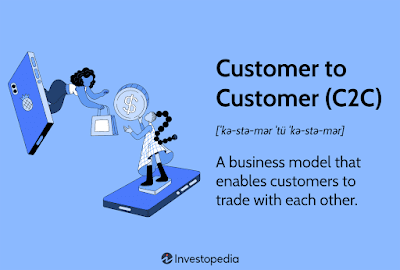Outline of the Article
- Introduction to E-commerce
- Definition and significance
- Evolution of e-commerce
- Types of E-commerce
- B2B (Business to Business)
- B2C (Business to Consumer)
- C2C (Consumer to Consumer)
- C2B (Consumer to Business)
- Key Components of E-commerce
- Website development
- Online payment systems
- Supply chain management
- Digital marketing strategies
- Benefits of E-commerce
- Convenience for consumers
- Global reach
- Cost-effectiveness
- Data-driven insights
- Challenges in E-commerce
- Cybersecurity threats
- Competition
- Logistics and shipping issues
- Customer trust and satisfaction
- Emerging Trends in E-commerce
- Mobile commerce (M-commerce)
- Voice commerce (V-commerce)
- Augmented Reality (AR) shopping experiences
- Personalization and Artificial Intelligence (AI)
- Impact of E-commerce on Traditional Retail
- Shift in consumer behavior
- Adaptation strategies for brick-and-mortar stores
- Omnichannel retailing
- Future of E-commerce
- Advancements in technology
- Sustainability in e-commerce practices
- Integration of virtual reality (VR) and AI
- Conclusion
E-commerce: Revolutionizing the Way We Shop
E-commerce, short for electronic commerce, has transformed the way businesses operate and consumers shop. It encompasses the buying and selling of goods and services over the internet, offering convenience, accessibility, and efficiency like never before. In this article, we delve into the intricacies of e-commerce, exploring its types, components, benefits, challenges, emerging trends, impact on traditional retail, and its future trajectory.
Introduction to E-commerce
E-commerce has become an integral part of the modern economy, enabling transactions to occur seamlessly across digital platforms. Its roots trace back to the 1960s, with the emergence of Electronic Data Interchange (EDI), but it wasn't until the 1990s that e-commerce began to gain widespread popularity with the advent of the World Wide Web.
Types of E-commerce
B2B (Business to Business)
B2B e-commerce involves transactions between businesses, such as manufacturers selling to wholesalers or suppliers.
B2C (Business to Consumer)
B2C e-commerce refers to transactions between businesses and individual consumers, the most common form of online shopping.
C2C (Consumer to Consumer)
C2C e-commerce facilitates transactions between individual consumers, often through online marketplaces or auction sites.
C2B (Consumer to Business)
C2B e-commerce occurs when individual consumers sell products or services to businesses, such as freelance work or influencer marketing.
Key Components of E-commerce
Successful e-commerce operations rely on several key components, including:
Website Development
A user-friendly and visually appealing website is essential for attracting and retaining customers.
Online Payment Systems
Secure and efficient online payment systems ensure seamless transactions and customer satisfaction.
Supply Chain Management
Efficient supply chain management is crucial for inventory management, order fulfillment, and timely delivery.
Digital Marketing Strategies
Effective digital marketing strategies, such as search engine optimization (SEO) and social media marketing, drive traffic and increase visibility.
Benefits of E-commerce
E-commerce offers numerous benefits for both businesses and consumers, including:
Convenience for Consumers
E-commerce allows consumers to shop anytime, anywhere, without the constraints of traditional store hours.
Global Reach
With e-commerce, businesses can reach a global audience, breaking down geographical barriers and expanding their customer base.
Cost-effectiveness
E-commerce eliminates many overhead costs associated with brick-and-mortar stores, such as rent and utilities, allowing businesses to offer competitive prices.
Data-driven Insights
E-commerce platforms generate vast amounts of data, enabling businesses to gain valuable insights into consumer behavior and preferences.
Challenges in E-commerce
Despite its benefits, e-commerce also presents several challenges, including:
Cybersecurity Threats
E-commerce platforms are vulnerable to cyber attacks, such as data breaches and phishing scams, which can compromise sensitive customer information.
Competition
The proliferation of e-commerce has led to increased competition, making it challenging for businesses to stand out in a crowded marketplace.
Logistics and Shipping Issues
Managing logistics and ensuring timely delivery can be complex, particularly for businesses operating on a global scale.
Customer Trust and Satisfaction
Building and maintaining customer trust is essential in e-commerce, as negative experiences can quickly spread through online reviews and social media.
Emerging Trends in E-commerce
The e-commerce landscape is constantly evolving, with several emerging trends shaping its future, including:
Mobile Commerce (M-commerce)
The proliferation of smartphones has fueled the growth of mobile commerce, allowing consumers to shop on-the-go through mobile apps and responsive websites.
Voice Commerce (V-commerce)
Voice-activated virtual assistants, such as Amazon's Alexa and Apple's Siri, are transforming the way consumers search for and purchase products online.
Augmented Reality (AR) Shopping Experiences
AR technology enables immersive shopping experiences, allowing consumers to visualize products in their own space before making a purchase.
Personalization and Artificial Intelligence (AI)
AI-powered algorithms analyze consumer data to deliver personalized recommendations and tailored shopping experiences.
Impact of E-commerce on Traditional Retail
The rise of e-commerce has had a profound impact on traditional retail, reshaping consumer behavior and forcing brick-and-mortar stores to adapt or face extinction.
Shift in Consumer Behavior
Consumers increasingly prefer the convenience and variety offered by online shopping, leading to a decline in foot traffic at physical stores.
Adaptation Strategies for Brick-and-Mortar Stores
To remain competitive, traditional retailers are investing in omnichannel strategies, integrating their online and offline presence to provide a seamless shopping experience.
Future of E-commerce
The future of e-commerce promises continued innovation and evolution, driven by advancements in technology and changing consumer preferences.
Advancements in Technology
Technological advancements, such as blockchain and Internet of Things (IoT), will further streamline e-commerce operations and enhance security.
Sustainability in E-commerce Practices
Consumers are becoming increasingly conscious of environmental issues, driving demand for sustainable e-commerce practices, such as eco-friendly packaging and carbon-neutral shipping.
Integration of Virtual Reality (VR) and AI
Virtual reality and AI technologies will revolutionize the e-commerce experience, offering immersive shopping experiences and personalized recommendations.
Conclusion
E-commerce has revolutionized the way we shop, offering unparalleled convenience, accessibility, and choice. However, it also presents challenges, such as cybersecurity threats and increased competition. By embracing emerging trends and adapting to changing consumer preferences, businesses can capitalize on the opportunities offered by e-commerce and thrive in the digital age.
















